
The Metropolitan Area Express (MAX) is a light rail system serving the Portland metropolitan area in the U.S. state of Oregon. Owned and operated by TriMet, it consists of five lines connecting the six sections of Portland; the communities of Beaverton, Clackamas, Gresham, Hillsboro, Milwaukie, and Oak Grove; and Portland International Airport to Portland City Center. Trains run seven days a week with headways of between 30 minutes off-peak and three minutes during rush hours. In 2019, MAX had an average daily ridership of 120,900, or 38.8 million annually. Due to the COVID-19 pandemic, which impacted public transit use globally, annual ridership plummeted, with only 14.8 million riders recorded in 2021.

The MAX Blue Line is a light rail line serving the Portland metropolitan area in the U.S. state of Oregon. Operated by TriMet as part of the MAX Light Rail system, it connects Hillsboro, Beaverton, Portland, and Gresham. The Blue Line is the longest in the network; it travels approximately 33 miles (53 km) and serves 48 stations from Hatfield Government Center to Cleveland Avenue. It is the busiest of the five MAX lines, having carried an average 55,370 riders each day on weekdays in September 2018. Service runs for 221⁄2 hours per day from Monday to Thursday, with headways of between 30 minutes off-peak and five minutes during rush hour. It runs later in the evening on Fridays and Saturdays and ends earlier on Sundays.

The MAX Yellow Line is a light rail line serving Portland, Oregon, United States. Operated by TriMet as part of the MAX Light Rail system, it connects North Portland, Portland City Center, and Portland State University (PSU). The line serves 17 stations; it runs north–south from Expo Center station to PSU South/Southwest 6th and College station, interlining with the Green and Orange lines within the Portland Transit Mall. Service runs for 21 hours per day with headways of up to 15 minutes. The Yellow Line is the fourth-busiest service in the MAX system; it carried an average 12,960 riders per weekday in September 2019.

Mall/Southwest 4th Avenue and Mall/Southwest 5th Avenue were a pair of light rail stations in Portland, Oregon, United States, served by TriMet as part of the MAX Light Rail system. Built into the sidewalk at Southwest Yamhill and Morrison streets between 4th and 5th avenues in downtown Portland, the Mall stations were served by the Blue and Red lines upon closing. They had also been served by the Yellow Line from May 2004 to August 2009.

Goose Hollow/Southwest Jefferson Street is a light rail station on the MAX Blue and Red Lines in the Goose Hollow neighborhood of Portland, Oregon. It is the third stop westbound on the Westside MAX alignment and makes several cameo appearances in the movie What the Bleep Do We Know!? as the stop where Marlee Matlin's character boards the train to get into town.

Kings Hill/Southwest Salmon Street is a former light rail station in Portland, Oregon, United States, which was served by the Blue and Red lines of TriMet's MAX Light Rail. The station was situated within the Goose Hollow neighborhood. Its incorrectly punctuated name refers to the hillside to the west of the station, which has historically been referred to as King's Hill. A section of King's Hill, which contains many historic buildings, qualified for inclusion within the King's Hill Historic District, the easternmost boundary of which is at SW 21st Avenue.

Pioneer Square South and Pioneer Square North are a pair of light rail stations in Portland, Oregon, United States, served by TriMet as part of the MAX Light Rail system. Situated directly west of the Portland Transit Mall at Pioneer Courthouse Square in downtown Portland, they occupy the sidewalk on Yamhill and Morrison streets between Broadway and 6th Avenue. The stations consist of one side platform each; trains traveling eastbound stop at Pioneer Square South while trains traveling westbound stop at Pioneer Square North.

Like transportation in the rest of the United States, the primary mode of local transportation in Portland, Oregon is the automobile. Metro, the metropolitan area's regional government, has a regional master plan in which transit-oriented development plays a major role. This approach, part of the new urbanism, promotes mixed-use and high-density development around light rail stops and transit centers, and the investment of the metropolitan area's share of federal tax dollars into multiple modes of transportation. In the United States, this focus is atypical in an era when automobile use led many areas to neglect their core cities in favor of development along interstate highways, in suburbs, and satellite cities.
Portland is "an international pioneer in transit orientated developments."

The MAX Green Line is a light rail service in Portland, Oregon, United States, operated by TriMet as part of the MAX Light Rail system. It is 15 miles (24.1 km) long and serves 30 stations from the PSU South stations to Clackamas Town Center Transit Center; it connects Portland State University (PSU), Portland City Center, Northeast Portland, Southeast Portland, and Clackamas. The Green Line is the only service that shares parts of its route with the four other MAX services, sharing the Portland Transit Mall with the Orange and Yellow lines and the Banfield segment of the Eastside MAX with the Blue and Red lines. Southbound from Gateway/Northeast 99th Avenue Transit Center, it operates the Interstate 205 (I-205) segment through to Clackamas Town Center. Service runs for approximately 211⁄2 hours daily with a headway of 15 minutes during most of the day. It is the third-busiest line in the system, carrying an average of 19,160 riders per day on weekdays in September 2019.
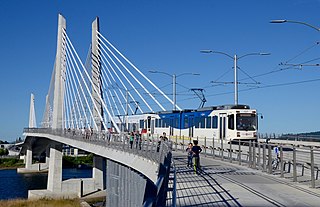
The MAX Orange Line is a light rail line serving the Portland metropolitan area in the U.S. state of Oregon. Operated by TriMet as part of the MAX Light Rail system, it connects Portland City Center, Portland State University (PSU), Southeast Portland, Milwaukie, and Oak Grove. The line serves 17 stations and runs for 201⁄2 hours per day with headways of up to 15 minutes. It averaged 3,480 daily weekday riders in September 2020.
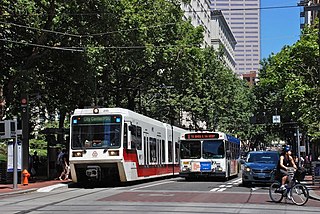
The Portland Transit Mall is a 1.2-mile (1.9 km) public transit corridor that travels north–south through the center of downtown in Portland, Oregon, United States. It comprises a pair of one-way streets—6th Avenue for northbound traffic and 5th Avenue for southbound—along which two of three lanes are restricted to transit buses and light rail vehicles only. As of September 2022, the corridor is served by the Green, Orange, and Yellow lines of MAX Light Rail; Frequent Express; and over a dozen local bus routes, all of which are services of TriMet, the transit agency operating within the Oregon side of the Portland metropolitan area. C-Tran, the transit agency for Clark County, Washington, additionally serves it with two express bus routes—#105 I-5 Express and #164 Fisher’s Landing Express.

PSU South/Southwest 6th and College and PSU South/Southwest 5th and Jackson are a pair of light rail stations on the MAX Green, Orange and Yellow Lines in Portland, Oregon. Together, they serve as the southern passenger terminus—one for departures only and the other for arrivals only—of the Portland Transit Mall MAX line. The stations opened on September 2, 2012.
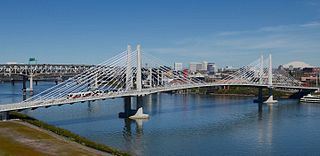
Tilikum Crossing, Bridge of the People is a cable-stayed bridge across the Willamette River in Portland, Oregon, United States. It was designed by TriMet, the Portland metropolitan area's regional transit authority, for its MAX Orange Line light rail passenger trains. The bridge also serves city buses and the Portland Streetcar, as well as bicycles, pedestrians, and emergency vehicles. Private cars and trucks are not permitted on the bridge. It is the first major bridge in the U.S. that was designed to allow access to transit vehicles, cyclists and pedestrians but not cars.

Southwest 6th & Pine and Southwest 5th & Oak stations are a pair of light rail stations on the MAX Green, Orange and Yellow Lines in Portland, Oregon. It is the 3rd stop southbound on the Portland Transit Mall extension.

Pioneer Courthouse/Southwest 6th and Pioneer Place/Southwest 5th stations are a pair of light rail stations on the MAX Green, Orange and Yellow Lines in Portland, Oregon. They are the 4th stop southbound on the Portland Transit Mall MAX extension. The Pioneer Courthouse/Southwest 6th station is served only by the Green and Yellow Lines, and the Pioneer Place/Southwest 5th station is served only by the Green and Orange Lines. Originally, from the opening of these stations in 2009 until 2015, the Yellow Line served both, but in September 2015 the then-new Orange Line replaced the Yellow Line at all southbound stations on the transit mall.
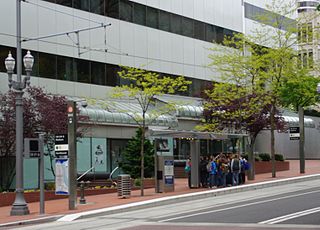
Southwest 6th & Madison Street and City Hall/Southwest 5th & Jefferson Street stations are a pair of light rail stations on the MAX Green, Orange and Yellow Lines in Portland, Oregon. It is the fifth stop southbound on the Portland Transit Mall extension.
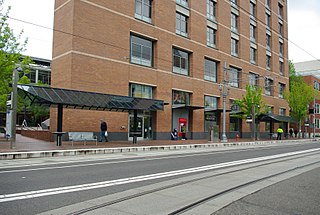
The PSU Urban Center stations are light rail stations on the MAX Green, Orange and Yellow Lines in downtown Portland, Oregon, United States, located adjacent to the PSU Urban Center, of Portland State University. The northbound platform is the PSU Urban Center/Southwest 6th & Montgomery station, and the southbound platform is the PSU Urban Center/Southwest 5th & Mill station. The stations opened on August 30, 2009, and for the next three years they were temporarily the southern passenger terminus of the Portland Transit Mall MAX extension, awaiting construction of the PSU South stations. The latter opened on September 2, 2012, and the change made PSU Urban Center the second stop northbound and the next-to-last stop southbound on the Portland Mall MAX lines.

South Waterfront/South Moody, formerly South Waterfront/Southwest Moody, is a combined light rail and bus station located at 698 Southwest Porter Street in the South Waterfront neighborhood of Portland, Oregon, at the west end of the Tilikum Crossing bridge. It is serviced by the MAX Orange Line and TriMet buses. Portland Streetcar travels through it but does not service it.

Trio is an outdoor 2013 art installation by Seattle artist Elizabeth Conner, installed at the MAX Orange Line's Lincoln Street/Southwest 3rd Avenue MAX Station in Portland, Oregon, United States.

Kerf is an outdoor series of two pigmented cast concrete sculptures by Thomas Sayre, installed at the MAX Orange Line's Southeast Tacoma/Johnson Creek station in the southeast Portland, Oregon portion of the Ardenwald-Johnson Creek neighborhood, which straddles the border between Portland and Milwaukie, Oregon.






















